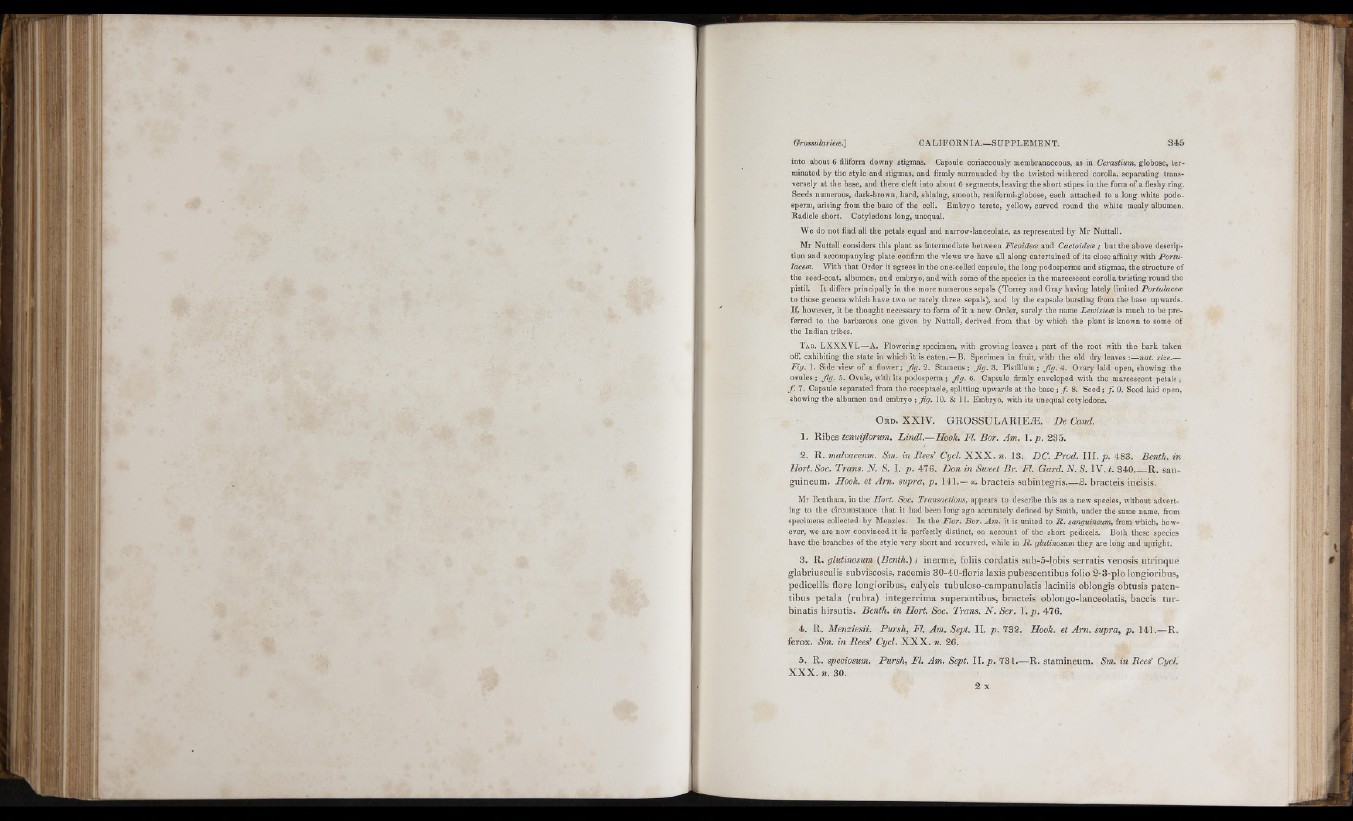
into about 6 filiform downy stigmas. Capsule coriaceously membranaceous, as in Cerastium, globose, te rminated
by the style and stigmas, and firmly surrounded by the twisted withered corolla, separating transversely
at the base, and there cleft into about 6 segments, leaving the short stipes in the form of a fleshy ring.
Seeds numerous, dark-brown, bard, shining, smooth, reniformUglobose, each attached to a long white podo-
sperra, arising from the base of the cell. Embryo terete, yellow, curved round the white mealy albumen.
Radicle short. Cotyledons long, unequal.
We do not find all the petals equal and narrow-lanceolate, as represented by Mr Nuttall.
Mr Nuttall considers this plant as intermediate between Ficoideoe and Cactoideoe ; but the above description
and accompanying plate confirm the views we have all along entertained of its close affinity with Portulacece.
With that Order it agrees in the one-celled capsule, the long podosperms and stigmas, the structure of
the seed-coat, albumen, and embryo, and with some of the species in the marcescent corolla twisting round the
pistil. It differs principally in the more numerous sepals (Torrey and Gray having lately limited Portulaceoe
to those genera which have two or rarely three sepals), and by the capsule bursting from the base upwards.
If, however, it be thought necessary to form of it a new Order, surely the name Lewisieee is much to be preferred
to the barbarous one given by Nuttall, derived from that by which the plant is known to some of
the Indian tribes.
T a b . LXXXVI.— A . Flowering specimen, with growing leaves ; part of the root with the bark taken
off, exhibiting the state in which it is eaten.—B. Specimen in fruit, with the old dry leaves :—nat. size.—
Fig. 1. Side view of a flower; Jig, 2. Stamens ; Jig. 3. Pistillum ; Jig. 4. Ovary laid open, showing the
ovules ; Jig. 5. Ovule, with its podosperm ; Jig. 6. Capsule firmly enveloped with the marcescent petals ;
f . 7. Capsule separated from the receptacle, splitting upwards at the base ; / . 8. Seed ; f . 9. Seed laid open,
showing the albumen and embrj’o ; Jig. 10. & 11. Embryo, with its unequal cotyledons.
O r d . X X IV . G R O S S U L A R IEÆ . De Cand.
1. Ribes tenuifiorum. L in d l.—Hook. Fl. Bor. Am. \ . p . 235.
2. R. malvaceum. Sm. in Rees’ C y c l X X X . n. 13. DC. Prod. I I I . jo. 483. Benth. in
Hort. Soc. Trans. N . S. I. p . 476. Don in Sweet Br. Fl. Gard. N . S. IV . t. 3 40. R. sanguineum.
Hook, et A rn . supra, p . 141.—-a, bracteis subintegris.—fi. bracteis incisis.
Mr Bentham, in the Hort. Soc. Transactions, appears to describe this as a new speeies, without adverting
to the circumstance that it had been long ago accurately defined by Smith, under the same name, from
specimens collected by Menzies. In the Flor. Bor. Am. it is united to R . sanguineum, from which, however,
we are now convinced it is perfectly distinct, on account of the short pedicels. Both these species
have the branches of the style very short and recurved, while in R . glutinosum they are long and upright.
3. R. glutinosum {B en th .); inerme, foliis cordatis sub-5-lobis serratis venosis u trin q u e
glabriusculis subviscosis, racemis 30-40-floris laxis pubescentibus folio 2-3-plo longioribus,
pedicellis flore longioribus, calycis tubuloso-campanulatis laciniis oblongis obtusis p aten tibus
pe ta la (ru b ra) in teg e rrim a superantibus, bracteis oblongo-lanceolatis, baccis tu rbinatis
hirsutis. Benth. in Hort. Soc. Trans. N . Ser. l . p . 476.
4. R . Menziesii. Pursh, Fl. Am. S e p t II, p . 732. Hook, et Arn. supra, p . 141.— R.
ferox. Sm. in Rees’ Cycl. X X X . n. 26.
5. R. speciosum. Pursh, Fl. Am. Sept. I I./? . 731.— R. stamineum. Sm. in Rees’ Cycl.
X X X . ». 30.